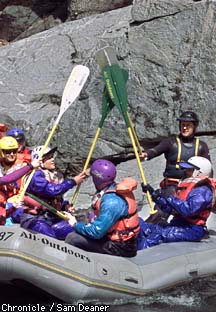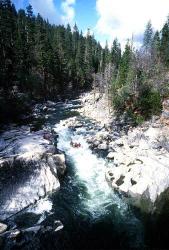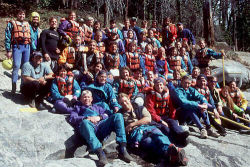Whitewater school offers safe ways to negotiate rapids
By Paul McHugh
Chronicle Outdoor Writer
On Sunday, at a rapid named Shrapnel, a fleet of rafts hurtled down a thundering, 15 foot-high waterfall, then caromed off boulders. One got impaled on a sunken tree and required a two-hour, emergency patch job to go onward. Next, all rafts had to be portaged over a ponderosa pine log stretching entirely across the North Fork Stanislaus River. The deep mossy canyon was leprous with patches of snow. Icy water soaked the 40 paddlers as they methodically worked their boats down-stream.
Why did these people bury themselves in tough problems on a difficult, cold, high-running river? So you won't have to. They were enrolled in an advanced guides' school for All-Outdoors, one of California's largest whitewater outfitters.
Last weekend's class was designed to infuse them with the skills that help keep commercial rafting a relatively safe form of thrill-seeking for the public. More than 220,000 clients will rely on trained guides like these as they take trips on California streams in the coming whitewater season. By far, most whitewater customers opt for sunny, pleasant trips on Class III-IV (moderate) rivers in the traditional, May-September season. A small percentage graduate to Class IV-V (difficult) streams. Some go on to brave Class V+ (extremely difficult) runs like this 3.5 stretch that includes Shrapnel's foamy explosions.
 After many runs, a few whitewater clients may start eyeing the guides and wonder if they have what it takes to join their ranks. The truth is, any whitewater runner can benefit from a guide class. But taking one is particularly important for those who plan to rent or buy rafts and make runs on their own. To enter advanced guide schools, you must possess a resume of work as a part-time guide. However, there are more than a dozen opportunities for anyone to take beginner guide classes with reputable outfitters. These begin in early May.
After many runs, a few whitewater clients may start eyeing the guides and wonder if they have what it takes to join their ranks. The truth is, any whitewater runner can benefit from a guide class. But taking one is particularly important for those who plan to rent or buy rafts and make runs on their own. To enter advanced guide schools, you must possess a resume of work as a part-time guide. However, there are more than a dozen opportunities for anyone to take beginner guide classes with reputable outfitters. These begin in early May.
In such classes, one may learn to: rig a raft, outfit and direct passengers; read and navigate rapids; and cope with mishaps. The key still is judgement.
Last year, good judgement seemed in short supply. Thirteen deaths occurred, 10 during high water from a melting El Nino snowpack. Most were due to private boaters trying to run rapids on an air mattress, a log, by swimming or by embarking on single-boat outings with no backup. Had these parties acquired a small part of the wisdom that's stock-in-trade for experienced guides, this toll would have been greatly reduced.
Whitewater paddlers who happily take commercial or private trips under direction from others, should, at minimum, seek to know how much experience their guides possess before committing.
At All-Outdoors advanced school, 35 guides, experienced on Class III runs, gathered near Calaveras Big Trees State Park to get a boost to the next level from five of the firm's senior guides.
We've offered basic training for 25 years," said the company's operations director, Scott Armstrong. "Four years ago, we added an advanced class. The gap between beginners and our senior guides, who got their stuff exploring runs in every extreme condition, had grown too great. We set this up so senior guides could directly transmit what they've learned."
The crew of students fanned across a broad spectrum. Only a few were young men who saw guiding as a likely full-time career. A third were women in their 20's, many of whom guided for summer jobs while earning college degrees. Present also were five teachers, two nurses, a lawyer, two stock brokers and a dentist; all used whitewater guiding to add outdoor excitement to their lives.
Bob Lee, 31, a broker at Schwab's in Menlo Park, found some transference between river guiding and financial work.
"There's great uncertainty in both," Lee said. "You must build up credibility with both raft passengers and investment clients. You need to earn their trust, convincing them to do what's right for them and for you. Then, at a certain point, you just have to pull the trigger and go for it."
Armstrong, 36, whose days on the Stan began by rafting with his parents at age 6, makes the same point.
"If there's no turning back, why be fearful?" Armstrong says. "Once past the lip of a rapid, stay entirely in the moment."
 Guide school prepares people to plunge into such moments with conviction. The senior guides spent the first two days teaching on the commercially-run, Class IV stretch of the North Stan. It extends from Stanislaus National Forest land at the Sourgrass put-in, to a take out at Calaveras State Park. The third day went further.
Guide school prepares people to plunge into such moments with conviction. The senior guides spent the first two days teaching on the commercially-run, Class IV stretch of the North Stan. It extends from Stanislaus National Forest land at the Sourgrass put-in, to a take out at Calaveras State Park. The third day went further.
Some of the practical lessons:
Your body as watercraft - Because anyone can be bounced out midstream, dress warmly (wetsuit or drysuit), always wear a life vest, add a helmet for rapids above Class IV.
Read the river - Scout rapids from the bottom as well as the top, to spot submerged rocks and obstacles, and read the influence of various jets, waves and hydraulic reversals. Devise a route that is you Plan A. Have a Plan B. And be prepared to improve.
Moderate speed - Float at the speed of current or slower, to gain maximum time for maneuvers. Save hard charging to punch thorough big holes or reversing waves. Fully exploit subtle currents or eddies to adjust speed, position and angle.
Deploying rules like these, Lee went for broke as acting captain of Armstrong's five-person paddle raft, taking on "Convulsion", a complex Class IV rapid, located midway down the first run.
Afterwards, Lee wore a wide grin and felt this rapid was a breakthrough. "I felt scared of responsibility for possible carnage," he said. "But as soon as we hit the entrance, all fear was gone. I could concentrate on hitting lines and giving commands. When we finished successfully, it was pure exhilaration."
 On the third and final day, all skills met a thorough test on the Class V+ stretch downstream of Calaveras park. This three-mile run was planned to last about three hours. Yet, unraveling the run's hazards took more than seven. That day brought lessons in teamwork, optimism amid harsh elements and coping with the unexpected.
On the third and final day, all skills met a thorough test on the Class V+ stretch downstream of Calaveras park. This three-mile run was planned to last about three hours. Yet, unraveling the run's hazards took more than seven. That day brought lessons in teamwork, optimism amid harsh elements and coping with the unexpected.
Hardy pioneers settled California, wrestling with challenges like winching wagons over high Sierra passes. In modern times, working rafts down a tough whitewater stream is one of the few ways left for us to access similar physical and psychological skills. A lesson of advanced guide school is that the reward for running hard whitewater extend far beyond mere thrills and enter the realm of nurturing human character.
Want more information about All-Outdoors Guide Schools? Click here!